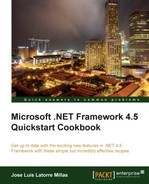The Dispatcher class is a very common way of accessing the UI thread while we are on another thread.
With WPF 4.5 we have some new methods for synchronous and asynchronous operations, which make this Dispatcher class more async and await friendly. Another improvement is that Dispatcher.Invoke and Dispatcher.InvokeAsync are now able to return a value.
Finally, we also have a new parameter of CancellationToken type, which provides the obvious capability of being able to cancel dispatched tasks.
In the following steps we will see how to use the Dispatcher class to dispatch a task that accesses the UI thread.
- First open Visual Studio 2012 and create a new project. We will select the WPF Application template from the Visual C# category and name it
WPFDispatcher. - Open the
MainWindow.xamlview and add a Button Click event, name itbtnDispatcherand enter1as the content. - Open the
MainWindow.xaml.cscode and change theMainWindowclass code as follows:public MainWindow() { InitializeComponent(); this.btnDispatcher.Click += btnDispatcher_Click; } void btnDispatcher_Click(object sender, RoutedEventArgs e) { TestNewDispatcherAsyncMethod(); } public async void TestNewDispatcherAsyncMethod() { // Usage of the InvokeAsync method var TaskDoSomething = await Dispatcher.InvokeAsync<Task<string>>(DoSomething); // We wait for the task to finish TaskDoSomething.Wait(); // Getting the result from the finished task string resultFromTask = TaskDoSomething.Result; // Usage of the Invoke method which returns a value of a defined type var returnedOject = Dispatcher.Invoke<string>( DoSomethingElse); } private string DoSomethingElse() { return "hi"; } private async Task<string> DoSomething() { //As we are being dispatched we could access the UI thread and update-change something there... String num = this.btnDispatcher.Content.ToString(); int iNum; int.TryParse(num, out iNum); iNum = iNum + 1; this.btnDispatcher.Content = iNum.ToString(); return "I should do something..."; } - We can now execute the code and click the button. For every click it will increase its value by one.
We have used one of the new Dispatcher methods, which can be called asynchronously.
// Usage of the InvokeAsync method var TaskDoSomething = await Dispatcher.InvokeAsync<Task<string>>(DoSomething);
The example illustrates how to receive the result of Task where we are changing a UI element and returning a value.
We can observe that we are executing a dispatcher operation asynchronously, which is in sync with the UI thread.
We are also invoking it in the usual non-asynchronous way with:
// Usage of the Invoke method which returns a value of a defined type var returnedOject = Dispatcher.Invoke<string>( DoSomethingElse);
As you can see, we can now return a result value of a specific type with a Dispatcher.Invoke method.
To complete the example, the DoSomething asynchronous method makes a very simple change on the UI thread.
If we take a look at the new methods that the Dispatcher class provides, we find the CancellationToken method, which enables us to cancel an action (or prevent it from being executed). This method belongs to the .NET 4.0 Cancellation Framework, which is useful for a proper implementation of the unit of work pattern.
We just saw how to use two of the most useful new methods, but there are a lot more to be explored.
